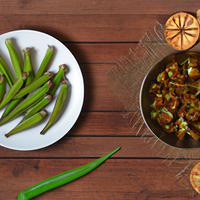
1 serving (100 grams) contains 200 calories, 3.0 grams of protein, 10.0 grams of fat, and 22.0 grams of carbohydrates.

Log this food in SnapCalorie

Nutrition Information
Calories |
500 | ||
|---|---|---|---|
% Daily Value* |
|||
| Total Fat | 25 g | 32% | |
| Saturated Fat | 5 g | 25% | |
| Polyunsaturated Fat | 0 g | ||
| Cholesterol | 0 mg | 0% | |
| Sodium | 750 mg | 32% | |
| Total Carbohydrates | 55 g | 20% | |
| Dietary Fiber | 7.5 g | 26% | |
| Sugars | 5 g | ||
| protein | 7.5 g | 15% | |
| Vitamin D | 0 mcg | 0% | |
| Calcium | 100 mg | 7% | |
| Iron | 2.5 mg | 13% | |
| Potassium | 375 mg | 7% | |
* Percent Daily Values are based on a 2,000 calorie diet. Your daily values may be higher or lower depending on your calorie needs.
Food Attributes
Source of Calories
About Fried oakra
Fried okra is a beloved dish in Southern cuisine, often recognized for its crispy texture and rich flavor. The main ingredient, okra, is a green vegetable known for its high fiber content, vitamins A and C, and antioxidant properties. Typically, the dish is made by coating sliced okra in a seasoned mixture of cornmeal and flour, then frying it in oil until golden brown. While frying enhances its crunchy appeal, it does add extra calories and fat, making moderation important for health-conscious diners. Okra itself has numerous benefits, including supporting digestion and providing essential nutrients, but the frying process reduces its overall nutritional value. Despite this, fried okra remains a cherished comfort food, offering a satisfying way to enjoy this nutrient-packed vegetable. Pairing it with lighter dishes can help balance its indulgent nature while celebrating its Southern roots.



